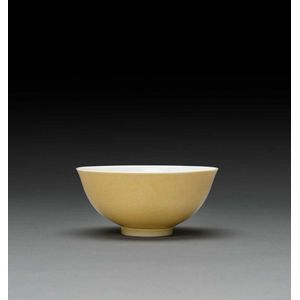Imperial Yellow Dragon Bowl from Guangxu Period
You must be a subscriber, and be logged in to view price and dealer details.
Subscribe Now to view actual auction price for this item
When you subscribe, you have the option of setting the currency in which to display prices to $Au, $US, $NZ or Stg.
- Imperial Yellow - Imperial yellow, also called "Chinese Yellow" and "Royal Yellow" is an auspicious colour in Chinese culture.
It was the colour of Imperial China and the symbolic colour of of the five legendary emperors of ancient China. The colour was used to decorate royal palaces and used in the clothing of the emperors. - Incised - A record of a name, date or inscription, or a decoration scratched into a surface, usually of a glass or ceramic item with a blunt instrument to make a coarse indentation. Compare with engraving where the surface is cut with a sharp instrument such as a metal needle or rotating tool to achieve a fine indentation.
- Imperial Yellow - Imperial yellow, also known as "yangqing" in Chinese, is a bright, intense shade of yellow that was historically reserved for the exclusive use of the Chinese imperial family. It was considered the most prestigious and luxurious of all colours, and was used to adorn a wide variety of imperial goods, including porcelain.
Chinese porcelain decorated with imperial yellow was highly prized, and was often used to create exquisite pieces of imperial tableware, such as plates, bowls, and cups. The use of imperial yellow on porcelain was a symbol of the emperor's power and authority and was intended to impress and intimidate visitors to the imperial court.
The process of creating imperial yellow porcelain involved a highly complex and labour-intensive process, which was kept secret by the imperial court. The exact recipe for the yellow glaze used on imperial porcelain is still unknown, although it is thought to have been a combination of lead, tin, and antimony, with the addition of a small amount of iron oxide to achieve the distinctive colour.
This item has been included into following indexes:
- Chinese ceramics, decoration - Imperial yellow 37
-
Chinese ceramics, dynasty mark or period
- Guangxu mark 344
- vases, Imperial style 135
- Chinese ceramics, item type - bowls and dishes, other 1,985
Visually similar items

A small Chinese Imperial yellow bowl, Guangxu mark and period (1875-1908), The exterior with an egg yolk glaze and incised with a pair of dragons in pursuit of a flaming pearl amongst clouds, 10.9 cm diameter, 5.9 cm high. Provenance: Ray and Vicki Tregask

A small Chinese Imperial copper red dish, Qianlong mark and period (1736-1795), The even sang de boeuf glaze neatly stopped at the foot rim, six-character seal mark to the base, 11.1 cm diameter. Provenance: Christie's, Hong Kong, January, 1989

A modern celadon studio-pottery bowl, late 20th century 27 cm diam. Provenance: NSW Private Collection, acquired from David Jones

A Cizhou persimmon glaze tea bowl, Jin dynasty (1115-1234), finely potted with a narrow band of lustrous black glaze encircling a groove band below the mouth rim, overall covered with a fine persimmon glaze with small black stripes, 11 cm diameter. Provena
